The 7 Best Plinth Heaters on the Market (Reviews)
Plinth heaters, also known as toe kick heaters, present a unique opportunity to warm your house without eating up floor or wall space. With a modest investment, you can kick your bulky old radiator to the curb, freeing up room to renovate your kitchen, cloakroom, or garage the way you’ve always wanted – without sacrificing on comfort or energy efficiency!
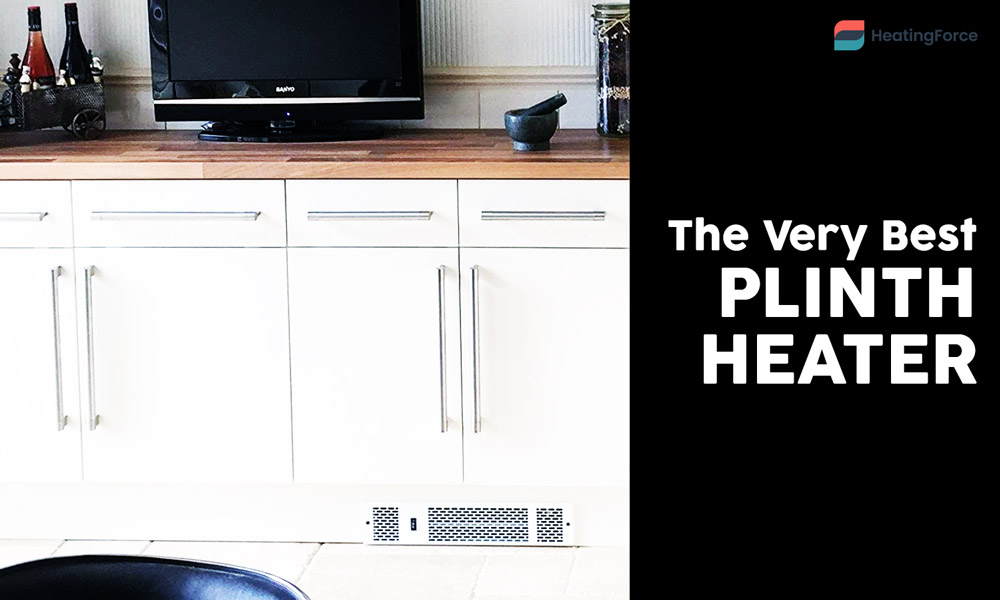
If you’re ready to make the upgrade, you’re due for some comparison shopping. Today, we present to you the results of our own market research — the top seven plinth heaters for any home or budget. Hopefully, you’ll find the one that meets your needs and allows you to open up your floor plan and stay warm this Winter.
The best plinth heater (including hydronic, electric, and dual-fuel heaters)
Being a somewhat specialist heating solution, it won’t do to simply run down to the appliance shop and pick up the first plinth heater that fits your budget or aesthetic. There are some logistics to consider, from intended usage to energy efficiency to the size of the room you need heated (and more besides).
Below, we review seven of the best plinth heaters. The first three are pure electric plinth heaters, the second three are hydronic, while the final is a dual-fuel model. We’ll cover who is best served by each model, and make comment on their best (and worst) features.
1. Winterwarm WWFH20E (Electric Plinth Heater)
Editor’s Choice: Best Electric Plinth Heater Overall
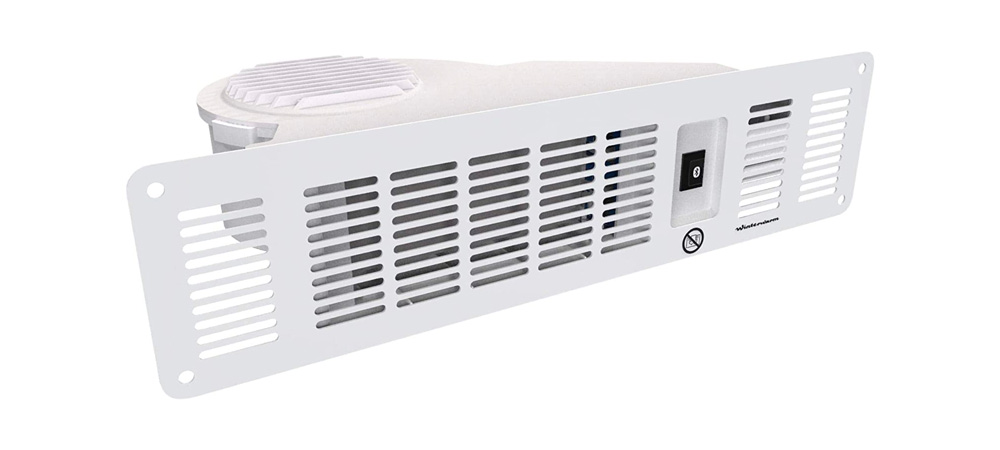
You may or may not have heard of Winterwarm before, but you’ve almost certainly heard of their Dublin-based parent company, Glen Dimplex. With nearly 50 years’ experience producing top-quality heating solutions for the UK market and abroad, the WWFH20E ought to be nothing short of fantastic.
Of course, reputation alone isn’t enough to earn the top spot on our list of the best plinth heaters! On its own merits, the WWFH20E is easy to recommend to almost anyone; it occupies the sweet spot for heat output, perfectly matching the needs of the average UK kitchen with its 2000W heating element.
Unlike most plinth heaters, which limit you to on/high/off settings, you have full thermostatic control over the WWFH20E. Best of all, you don’t have to bend down on your knees to fiddle with knobs; instead you can use the included Bluetooth remote control to dial in the perfect amount of heat.
Once the temperature’s reached your chosen setting, the WWFH20E conscientiously shuts itself off to save on energy, rather than running dumbly until you bother to direct it otherwise. Moreover, you can programme your electric plinth heater on a 7-day schedule to truly maximise efficiency and minimise your power bills.
The Winterwarm WWFH20E doesn’t skimp on safety, either. While you shouldn’t neglect to give it a light dusting on occasion, you can generally rest easier knowing it’s got a safety cutout for preventing unsafe temperatures.
WWFH20E quick stats
- 2000W heating element
- 1-year warranty
- 7-day programmable thermostat
- Attractive white grille with neon power indicator
- 41 x 11 x 21.5 cm
Complaints or criticisms
There is some confusion online with outdated product listings. To clarify, this electric plinth heater does NOT have a fan-only mode like its predecessor. While pictures will not display the neon indicator light, rest assured that it is indeed there!
Otherwise, the only real complaint is that on the highest setting, the grille can get a bit hot to the touch. But smart use of the thermostat should prevent this from being an issue in practice.
Who’s it for?
If you’re looking for a great all-round electric plinth heater, it’s hard to do better than the Winterwarm WWFH20E. It easily slots into any available space on your property, requiring only modest DIY expertise to fit (and is a cheap job should you instead opt to hire a professional).
With thermostatic control and quality electronics, the WWFH20E is an energy-efficient pick as far as electric plinth heaters go. Coupled with the low purchase price and a 1-year guarantee from a trusted domestic manufacturer, you’ve got a real winner in terms of value for money.
2. Smith’s Space Saver SS2EW (Electric)
Ideal for Home Renovations
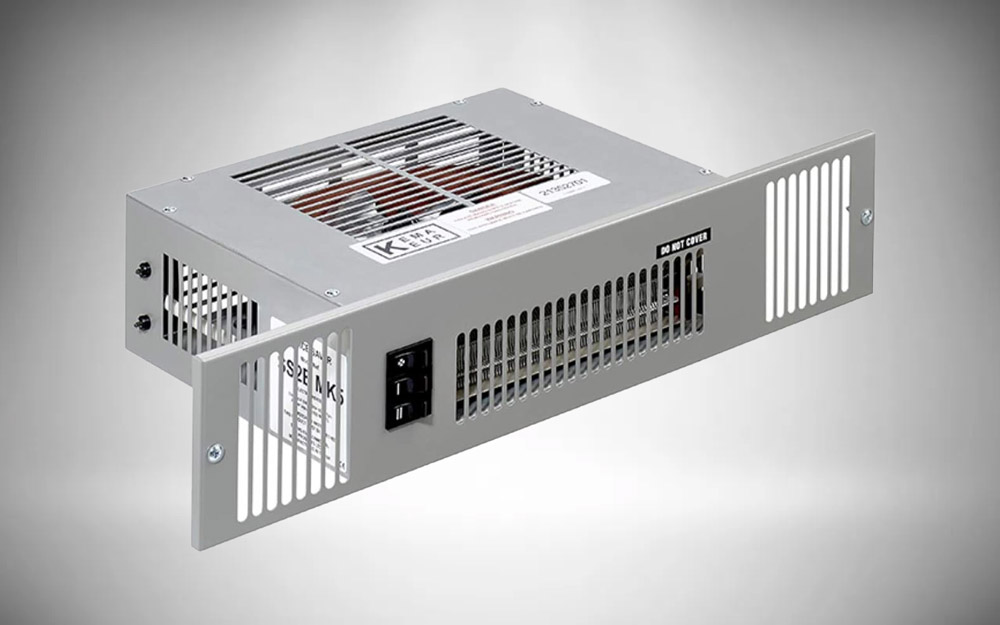
While plinth heaters are by definition compact, the aptly-named Space Saver SS2EW indeed makes for a neat package. And, being an electric plinth heater, it can really slot in just about anywhere you need heat–be it a workshop, garage, home extension, conservatory, kitchen, or any other room with access to the electrical mains.
If that weren’t enough for flexibility, Smith’s offers six different coloured overlay plates for the SS2EW grille to perfectly complement any décor. This is ideal for renovations, as you can easily change the default brushed steel to an aluminium, chrome, gold, brown, or black face to complete the new look.
So, it’s clear that the SS2EW’s size and variable aesthetics make for easy redecorating, but how does it perform? Smith’s have equipped this plucky little plinth heater with a powerful heating element, nominally rated at 1kW with an optional boost up to 2kW. In either mode, the SS2EW punches above its weight class with outputs of 3410 BTU/hr and a whopping 6820 BTU/hr, respectively.
If the boost mode in particular sounds like more than you’d ever need for your small-medium sized kitchen, rejoice in Smith’s inclusion of a thermostatic control unit! Whether you need a slow-burning, efficient heat, or you’re just looking to blast away Old Man Winter’s icy grip around your ankles, just select the proper mode, then dial in the last few degrees with digital accuracy between 15° and 35°C.
And, unlike your run-of-the-mill heater, the SS2EW lives a double life during the Summer; just deactivate the heating element, and run the fan only to circulate cool air throughout the room. No matter the season, the fan runs at a hushed 42 dBA for a peaceful, comfortable household.
SS2EW quick stats
- 3-mode operation: 1kW, 2kW, fan-only
- Digital thermostat from 15-35°C
- Six coloured grille overlays available
- Amazing 5-year warranty from British manufacturer
- 50 x 10 x 14 cm
Complaints or criticisms
Some will bristle at the lack of a neon indicator, but we feel smart placement of the thermostat module goes a long way to mitigate any ambiguity. Sadly though, if the thermostat breaks or malfunctions, the plinth heater will cease to function until you get it repaired or replaced.
Who’s it for?
While the Smith’s SS2EW is easily the most expensive electric plinth heater package on our list, it does much to justify your investment. Whereas most plinth heaters lock you into one or two modes of operation, Smith’s enables you to truly control your heat output and energy consumption via the electronic control unit.
Moreover, Smith’s is an attractive pick for anyone who values buying British, rather than an overseas brand. They don’t rest on their domestic laurels, however, providing one of the industry’s best warranties–that’s 5 years’ peace of mind guaranteed on your investment.
3. CDA APH01SS (Electric)
Outstanding Value for Money
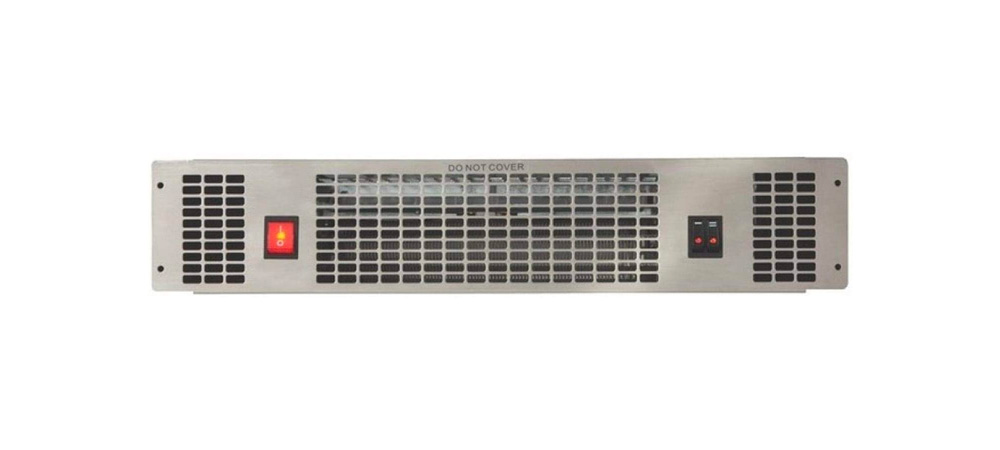
If bells and whistles are less your style than smart savings, then consider the CDA APH01SS. What it lacks in advanced features, it makes up for in reliability. And when you get down to brass tacks, shouldn’t you choose a plinth heater that just works when you need it?
CDA seems to think so, offering a sturdy stainless steel build that looks like it could survive a bomb going off. That’s not to say it’s altogether unattractive–there’s an elegant simplicity to be found in its almost-symmetrical grille design. But there are no options to swap out the faceplate, nor do the vents shoot for anything other than pure utilitarianism.
Ironically though, the APH01SS gets some things right where other more advanced units fail. There’s a bright red illuminating power indicator so you never have to guess whether the darn thing’s on or not. And while there’s no fancy remote or thermostatic control unit, the APH01SS doesn’t rely on external electronics to function (or fail, for that matter).
So in short, what you see is what you get! Need warm air? Flip switch number one for 1kW’s worth of heat production in an instant. If you need a boost, give switch number two a whack to double it. And yes, you can run the fan with both of these off during the Summer! No nonsense–just three temperature settings to sort you out pretty much any time of the year.
Keep in mind, simplicity doesn’t exclude safety. CDA kitted out their APH01SS with an automatic kill switch to prevent overheating. This will prevent damage or bodily harm from coming to you and your property, and will extend the service life of your electric plinth heater besides. Better yet, register within 28 days of purchase to validate your 5-year parts/2-year labour warranty.
APH01SS quick stats
- 3-mode operation: 1kW, 2kW, fan-only
- Brushed stainless steel grille
- Illuminated power switch
- Automatic safety cut out
- 50 x 10 x 22.5 cm
Complaints or criticisms
There’s absolutely nothing to indicate this being the case, but many mistakenly believe the APH01SS ships with a 3-prong plug. While you can easily swap the supplied leads for a proper plug for easier installation, this is not the default mode of installation. Like most electric plinth heaters, you’ll need to hook it up to a fused spur.
A more legitimate complaint is the noisy fan. While we’re willing to be it won’t matter too much in most kitchen settings, it may if you elect to install your plinth heater elsewhere in the house. As always, be aware of the pros and cons, and match the tool to the task.
Who’s it for?
The CDA APH01SS is the most functionally basic electric plinth heater on our list, but it is also the least expensive. This would make a fine, budget-conscious addition to a home extension or workshop where usage would be intermittent, rather than constant. That isn’t to say this is a wildly inefficient unit on its own, just that your control options are somewhat limited. Keep in mind that the fan runs a bit loud, as well.
Nevertheless, a low purchase cost, easy installation, and year-round hot/cold utility push the value-for-money meter into the green zone. Basic though the APH01SS may be, it’s very much a workhorse backed by a competent manufacturer guarantee.
4. Bidex Diamond 500 Hydronic Plinth Heater
Editor’s Choice: Best All-Round Hydronic Plinth Heater
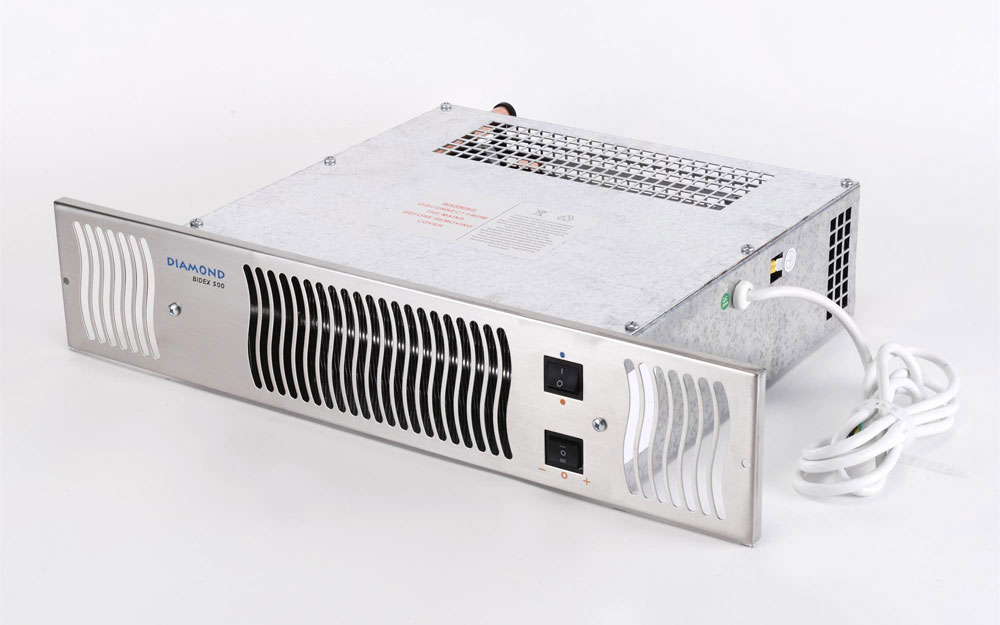
While hydronic plinth heaters are fairly well-known to be more expensive than their electric counterparts, UK-based company Bidex have endeavoured to keep their Diamond 500 affordable. Don’t let that fool you into thinking they’ve cut corners, however–they simply have the design and manufacturing prowess to produce top quality at scale without gouging the consumer.
On its own merits, though, the Diamond 500 stands out as an exceptional central heating plinth heater. You get a surprising amount of control on what is otherwise a fairly passive system, with three distinct modes of operation.
The first of these outputs 900W or around 3000 BTU/hr, hitting the sweet spot for the average size of UK kitchens. If there’s a bit more chill in the air or you simply have a larger space, you can kick on the boost for 1200W or ~4100 BTU/hr. Indeed, the Diamond 500 is ideal for spaces between 21m3 and 30m3 (with the boost).
During the warmer months when you won’t be running the central heating much at all, your toe kick heater won’t just lay there uselessly thanks to its independent fan control which also circulates cool air in aid of your aircon.
While the Diamond 500 is an effective heater, it’s also extremely efficient–offering average savings up to 24% better than an equivalent electric space heater! Coupled with a modest purchase price, it justifies your investment both in the short and long-term.
Aesthetically, we’re keen on the Bidex, which has a modern, clean facia punctuated by an elegant series of wavy vents. There’s no remote control, as it plays off your central heating thermostat–but it’s easy to toggle between the three operational modes with the dual switches. Flip the top for the fan, then select your level of heat on the bottom.
Diamond 500 quick stats
- 3-mode operation: 900W, 1200W, fan-only
- Modern white grille with wavy vents (silver, black and brown options also available)
- Zero maintenance, professional installation recommended
- Excellent 2-year warranty
- 50 x 10 x 40 cm
Complaints or criticisms
The Achilles heel of most affordable toe kick heaters, whether electric or hydronic, is a louder fan. Depending on where you install it in the house, this may be a non-issue. But if you’re expecting dead-quiet from the Diamond 500, you may be disappointed.
Who’s it for?
If saving money upfront and long-term is important to you (and we’re willing to be it is), then very few can match the Bidex Diamond 500. It is sheer value for money, with an affordable purchase price, exceptional operational efficiency, and low maintenance. All in all, there’s really no question why this is one of the best-selling plinth heaters on the market.
And while aesthetics is perhaps a secondary concern when picking a machine designed to hide away beneath your cabinetry, you’ll be well-pleased with the array of coloured grille options on offer from Bidex. Unleash your inner interior designer and transform your kitchen with the freedom afforded by the compact, handsome Diamond 500!
5. Thermix KPH-1500 Classic (Hydronic)
Reliable Efficiency for Medium Spaces
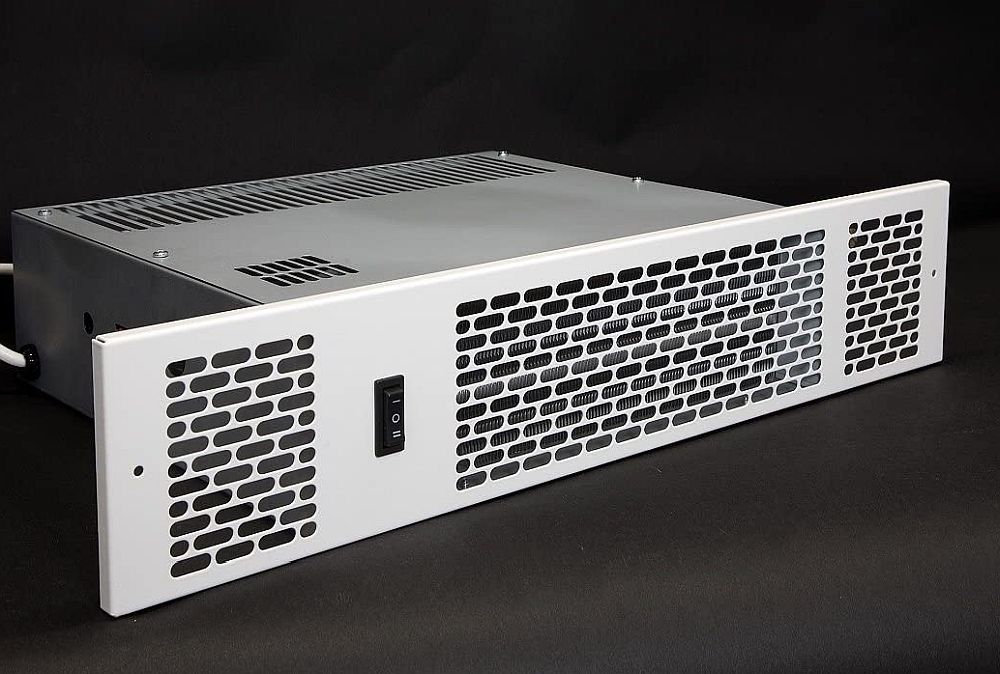
Another outstanding UK-made hydronic plinth heater, Thermix’s KPH-1500 occupies a slightly higher price point to serve larger spaces. Considering its intended use-case, we can forgive it for being a bit taller than the rest by about 10cm.
Nevertheless, following a competent installation, you can expect reliable, maintenance-free performance from your KPH-1500 for many years. The manufacturer guarantees the first two, but experience has shown this model to last far longer. It only requires an occasional dusting, and features the bare minimum moving parts and no fiddly digital bits to go wrong on you. Overall, the build quality is outstanding with no corners cut.
The KPH-1500 offers two modes of operation: the first has a nominal heat output of 4300 BTU/hr (1260W equivalent), while the boost offers a rather modest increase to around 4950 BTU/hr (1450W equivalent). Thermix rates their KPH-1500 for 30m3 spaces, but you can go a little bigger running the boost.
Being a more premium model, the complaints of noisy fans are mercifully absent with the KPH-1500 classic. And, as a natural extension of your central heating, hydronic plinth heaters are among the most energy-efficient heating solutions. Thus you’ll find the KPH-1500 lends itself to continuous use, respecting both your need for quiet and lower power bills alike.
Despite its considerable heat output, the KPH-1500’s grille remains safe to touch without fear for burns. This is in part due to a smart vent design, which minimises the total area of metal surface whilst maximising airflow. While certainly sleek, this facia presents a decidedly more conservative and understated aesthetic that slots in nicely almost anywhere. (This is especially true considering Thermix’s full offer of silver, white, and black options.)
KPH-1500 quick stats
- 2-mode operation: 1260W, 1450W
- Minimalist, high-flow vents that don’t get too hot to touch
- 3 choices of grille colour: silver, black, white
- Zero maintenance, professional installation recommended
- Excellent 2-year warranty
- 50 x 10.5 x 29 cm
Complaints or criticisms
This is a fairly Spartan plinth heater, eschewing bells and whistles in favour of pure reliability and performance. However, we feel Thermix ought not to have cut the ability to run the fan separately, as it’s always nice to get double duty out of your purchase in the warmer months.
Who’s it for?
Truth be told, we could easily recommend the KPH-1500 as the top hydronic plinth heater. After all, it boasts incredible efficiency, a sharp design with multiple grille options, and an affordable price point.
Ultimately, it comes down to picking the right heat output for the size of your room. As the average kitchen in the UK is somewhere shy of 30m3, the standard output already may be a bit more than you need. Moreover, if you’re trying to heat a small-ish room, you’ll probably never make use of that otherwise extremely handy boost feature.
But hey, if you’ve got the space for it, you’re really not going to be able to find more bang for buck than the KPH-1500. And if you’re the type who cares about buying domestic products, then rest easy purchasing from UK-based Thermix, especially with their 2-year warranty.
6. Smith’s Space Saver SS5 (Hydronic Heater)
High Output for Large Spaces
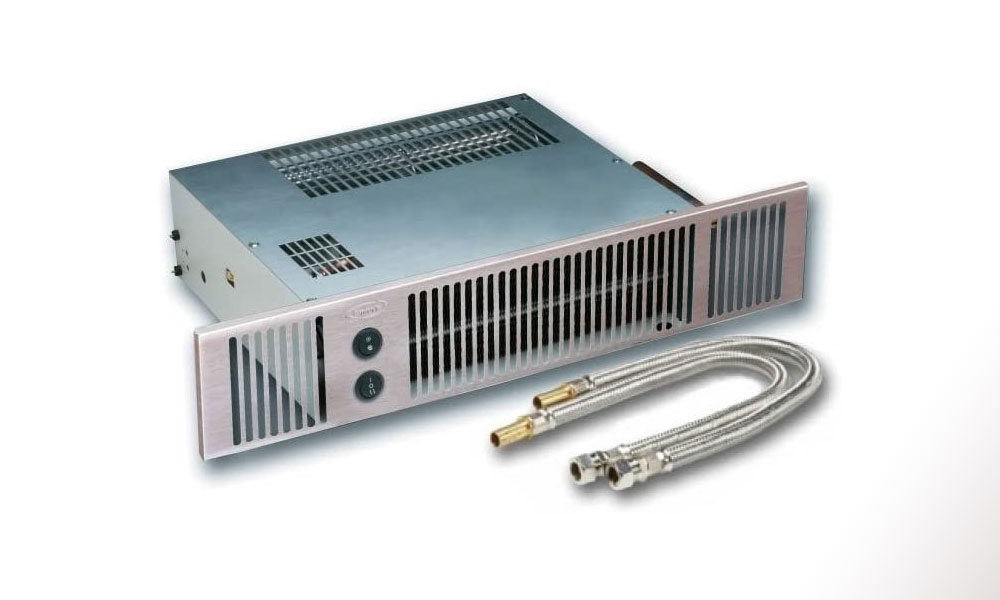
Yet again, we find ourselves happily recommending a UK-made product, this time in the form of Smith’s Space Saver SS5. It is the most expensive hydronic plinth heater, but the SS5 has horsepower enough to efficiently warm rooms as large as 37m3, and up to 41m3 boosted.
Tapping into your central heating system, the SS5 pipes in hot water through its internal convection array. The fan then blows the equivalent of 1300W or 4400 BTU/hr on the warm setting, or a whopping 1700W (5800 BTU/hr) on boost. That’s a lot of heat for sure, but since there’s no electrical heating element, the SS5 produces a gentle, natural warmth. This is especially agreeable to allergy sufferers and those to whom dry air is an irritant.
Like every model in the Space Saver plinth heater line, the SS5 offers big performance in a small package. It is thus highly permissive in what size plinth it can occupy, lending itself handily to your renovation efforts. That said, it’s fairly unremarkable in terms of aesthetics, but that’s less of a detriment to a heater designed to hide away out of sight, out of mind.
And despite the power of its fan, the SS5 runs quiet: just 25 dBA on normal and 43 dBA on high heat. There are no indicator lights, but then again hydronic plinth heaters have little need for such devices. Simply switch between heat and cool mode, set the fan speed to normal or boosted, and you’re off to the races!
Once purchased and installed, the SS5 performs thus whilst sipping the bare minimum power needed to run the fan. Depending on where you live, you can expect to pay close to a mere 8p per week (operating an average of 5 hours per day).
SS5 quick stats
- 3-mode operation: 1300W, 1700W, fan-only
- Gorgeous 5-year warranty and steadfast build quality
- Quiet operation
- Zero maintenance, professional installation recommended
- 49.8 x 10 x 28.8 cm
Complaints or criticisms
Truthfully, there’s not much! SS5 owners are quite content with their purchases. If we had to pick nits, we wish there were more facia colours on offer.
Who’s it for?
At the risk of repeating ourselves, the only reason we don’t give the Smith’s SS5 top billing is that it’s probably too much heat for smaller (aka UK-sized) kitchens. Otherwise, we have an excellent hydronic plinth heater made and designed in the UK, boasting fantastic performance all around.
The SS5 is a bit of a Plain Jane, but you’ll probably appreciate the wallflower aesthetic when you’re groggily stumbling towards your morning cuppa. Moreover, it’s whisper quiet at just 27dBA, so Smith’s has done a good job to keep their flagship plinth heater out of sight, out of mind. And despite its cavernous heating capacity, the Space Saver politely lives up to its name as one of the smallest models on this list.
Of the central heating plinth heaters, this one’s certainly the premium pick. But, if you’ve got a large space–and you want to get the most out of every inch of it–the Smith’s SS5 delivers value in spades.
7. Smith’s Space Saver SS5/Dual (Electric/Hydronic Dual Fuel Plinth Heater)
Editor’s Choice: Most Efficient Plinth Heater Year-Round

Despite the similar nomenclature to our previous entry, Smith’s SS5/Dual is a hybrid heater that uses both electricity and your central heating system to produce heat. It’s definitely a niche product with a price to match, but it may well be the perfect plinth heater for your home.
First, the basics. As a hydronic toe kick heater, it produces 1.3kW (or 4400 BTU/hr) at normal operation, and can be boosted to 1.7kW (or 5800 BTU/hr). Perhaps unsurprisingly, these stats mirror the SS5 pure hydronic model. On the electric side, its heating element runs at 1kW to produce a respectable 3450 BTU/hr.
A common question is whether these dual modes can run together, and alas they cannot. Far from being a disappointment, Smith’s have intentionally relegated the electric heater to a lesser output relative to the hydronic aspect. Why? It’s all about use-cases, allow us to explain:
When it’s really cold, you’re going to be running the heater more often. Thus, you really would prefer to have a hydronic plinth heater on the job, as it’s categorically more efficient than pure electric. It therefor makes sense that the SS5/Dual’s most powerful settings come from your central heating, rather than electrical draw.
But what about when it’s not quite so cold, or even warm outside? After all, kitchen tiles still get chilly overnight, and your garage or cloakroom can easily get draughty. An electric plinth heater fires on instantly, banishing the chill as long as you need it to. In practicum, you’ll likely use the electrical mode of the SS5/Dual more occasionally, mitigating the downside of lesser efficiency with instant comfort.
So in short, the SS5/Dual provides a gentle, efficient heat hydronically through the Winter; staves off chills in the Spring and Autumn; and even blows cool air only during the Summer.
SS5/Dual quick stats
- 4-mode operation: hydronic 1.3kW/1.7kW; electric 1kW; fan-only
- Year-round performance
- Flexible installation, though requires greater DIY expertise or a professional technician
- Silver grille
- 27dBA (or 43dBA with boost) noise output
- Amazing 5-year warrant
Complaints or criticisms
The only real complaint here is the price, which is nearly quadruple what the cheapest plinth heater on our list goes for. But if you’ve got the budget for it and anticipate the need for true year-round performance, it’s hard to recommend anything else.
It would be nice to have a remote of some kind, though this would inevitably drive the price up further for what is ultimately a convenience.
Who’s it for?
If the price tag hasn’t scared you off, there’s a lot to love about the Smith’s SS5/Dual. The obvious draw is that it truly installs anywhere you need it; got a new extension built onto the house? Install the SS5/Dual as a pure electric plinth heater, and carry on. Or, install it as normal into your kitchen, and enjoy the long-term energy efficiency of a hydronic plinth heater.
But the main reason this dual-fuel heater uses to justify its existence is the fact that certain rooms in the house can get unseasonably cold. Would you really want to turn on the central heating just to take the chill off your tile, stone, or wooden floors in the morning? It’s actually less efficient to wake the slumbering beast that is your combi boiler than it is to simply kick on a tidy little electric heater for a half an hour.
In short, the SS5/Dual is all about giving you options–namely, the best option for any season. You’re less likely to enjoy the full benefits of this heater if your floors and rooms stay fairly warm in the Fall and Spring. But if that isn’t the case, you won’t find a better buy than Smith’s SS5/Dual. It may cost a pretty penny upfront, but it will save you in the long run more than any other.
Buyer’s Guide – How to pick the right plinth heater?
We’ve gone into great depth reviewing the best plinth heaters, and have hopefully given you a clearer picture of which model is best for you. However, it’s easy to get lost in all the features, so we’ve condensed our recommendations into this quick buyer’s guide–intended to help you prioritise features according to your specific needs.
Matching BTU and wattage to room size
As with any heater, the most important consideration to make is matching output to what is required to efficiently and satisfactorily heat the room. In truth, this can be an endlessly complex matter, fraught with all sorts of variables like insulation, floor materials, latitude and climate, and of course, room size.
But generally, you don’t need to worry about all that too terribly much. Manufacturers provide average performance metrics, which should generally serve as an adequate indicator throughout the UK, regardless of the composition of your home. Here are a few ground rules to make sense of them:
- Electric plinth heaters use watts to denote how much power the heating element produces
- Hydronic plinth heaters lack a heating element, and thus their output is primarily measured in BTU/hr. However, most manufacturers also include the equivalent wattage to aid in direct comparison to other heaters’ performance specs.
- The best way to measure your room’s needs is by obtaining the square footage of your room, then multiply that number by 10. A 150m2 requires around 1500W, assuming an average ceiling height of 9ft. Compare this to the power output of your chosen heater, or else multiply 1500W by 3.41 to get 5115 BTU/hr for comparison along that metric.
- Keep in mind these numbers have wiggle room for the aforementioned physical variables of your home. Moreover, many heaters feature a boost that allows you to heat an even larger space, or the same space more quickly.
- A too-large heater will produce uncomfortable levels of heat unless it ships with some form of thermostatic control. Electric heaters may also trigger the overheat cut-out switch.
- Too-small heaters will never heat the room adequately, and waste energy trying.
Choosing a hydronic or electric plinth heater to fit your usage
With all other factors like heat output kept constant, here’s how to choose between the different types of plinth heaters. If you’re:
- Facing especially cold Winters and runing your heater all the time, go hydronic. These possess far superior energy efficiency, and produce a gentle, constant heat that is more comfortable over long periods. Central heating is slow and energy intensive to start, but sips power once it’s reached nominal temperatures.
- Running your plinth heater only occasionally, go electric. Not only do they fire up faster, but they actually require less energy to do so than starting your central heating system up from cold.
- Trying to heat a room which has ready access to your central heating system, in most cases, go hydronic for sheer efficiency (after all, most places in the UK do indeed experience cold Winters). Otherwise, your only option is to go electric, tapping into the mains to heat home extensions, garages, cloakrooms, and the like.
- Looking the cheapest upfront purchase, go electric. They’re less complicated to install, and cheaper for manufacturers to produce.
- Looking for the best overall utility and efficiency, go for dual-fuel (provided you don’t mind the larger upfront investment).
Convenience considerations
For the most part, plinth heaters require relatively little input from their owners. Hydronic plinth heaters are especially easy to operate, as in most cases you just need to raise your central heating thermostat to a specific temperature (often around 70°F).
Electric plinth heaters are a little less convenient by default, as they’re designed for more occasional or intermittent usage. Thus, you have to be more active in controlling the usage of your heater.
All plinth heaters have controls on their facia, which sits not-at-all-conveniently close to the floor. With this in mind, you may think that the hydronic heater wins for convenience, hands down, as you don’t need to get down on your hands and knees to turn it on and off. However, most good electric plinth heaters will ship with some form of remote control so you don’t have to strain yourself.
A word on installation, maintenance, and warranty
Unlike most larger radiators, plinth heaters do not strictly require professional installation. Electric plinth heaters are particularly easy to install via the fused spur, while hydronic heaters can make easy use of your existing piping (perhaps previously utilised by your old radiator). In these cases, the most difficult part is cutting the hole in your plinth with enough clearance above and below the heater for proper airflow. You’ll need the right tools and a little patience, but it can easily be done in an afternoon.
However, if you at all doubt your DIY skills or lack proximity to a spur or piping, then call a professional. Not only will they be able to handle installation safely, but you’ll guarantee the best functionality of your unit. Moreover, many manufacturers won’t honour warranties if there is any doubt that the installation was handled competently. Having a receipt of service to hand is the best proof you can have.
On that note, it’s important to choose heaters with warranties! Plinth heaters are fairly simple machines, and shouldn’t break down too often at all. However, they’re tricky to repair when they do break, and thus you’ll want the backing of the manufacturer to guarantee a minimum service life.
1 or 2 years is normal; 5 years is even better. Pay special attention to whether it is a complete warranty, or whether parts and labour are handled on separate timelines.
Finally, maintenance; there’s not much to it, but it is nevertheless important. Keep the vent holes free from dust, dirt, and debris with the occasional cleaning. Doing so will not only allow for more even heat distribution, but will also keep the fans (and electric heating elements) from getting gunked up.
Parting words
We’ve covered a lot of ground in this article, with the thrust of helping you decide which plinth heater is best for your home. There are a lot of variables to consider and even more models on the market to serve them; but with our buyer’s guide to hand, you should be easily able to make an informed purchasing decision.
Whether you’re looking for a high-efficiency hydronic plinth heater or a highly flexible and convenient electric one, there’s the perfect unit out there. You just need to be able to evaluate the various feature sets on offer–and hopefully you’re now better able to suss it all out!
Have you used plinth heaters before? What would you recommend for our readers to keep in mind before buying one? Or, do you have your eye set on one of the models we reviewed? Leave us a note in the comments below!